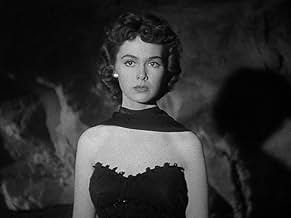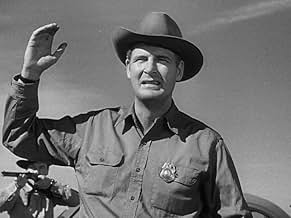A spaceship from another world crashes in the Arizona desert and only an amateur stargazer and a schoolteacher suspect alien influence when the local townsfolk begin to act strangely.A spaceship from another world crashes in the Arizona desert and only an amateur stargazer and a schoolteacher suspect alien influence when the local townsfolk begin to act strangely.A spaceship from another world crashes in the Arizona desert and only an amateur stargazer and a schoolteacher suspect alien influence when the local townsfolk begin to act strangely.
- Awards
- 1 win & 4 nominations total
- Posseman
- (uncredited)
- Dugan
- (uncredited)
- Man
- (uncredited)
- Sam
- (uncredited)
- Dave Loring
- (uncredited)
- Dr. Snell
- (uncredited)
- Perry
- (uncredited)
- Posseman
- (uncredited)
- Bob - Dr. Snell's Assistant
- (uncredited)
- Toby
- (uncredited)
- Posseman
- (uncredited)
- Mrs. Daylon
- (uncredited)
- Director
- Writers
- All cast & crew
- Production, box office & more at IMDbPro
Featured reviews
A moody and beautiful movie, with fine music by Henry Mancini. Many fans of Jack Arnold's sci-fi films consider this one his best (although personally I prefer `The Space Children' -- and so did Jack Arnold, according to his own statement).
Charles Drake (`Tobor the Great') is the skeptical sheriff. Russell Johnson plays both a human and an alien (a treat for genre' fans). The supporting cast includes Joe Sawyer and Kathleen Hughes. Special effects by David S. Horsely and the great Clifford Stine. Makeup by Bud Westmore, of the famous Westmore family who contributed much to all the `Star Trek' spin-offs.
Originally released in 3-D. A 3-D tape was available a few years ago, but the quality was not good . . . sad to say.
Arnold uses Theremin music to great effect, the photography is eerie, dialog (by Ray Bradbury) poetic, and the alien is a large crawling mass with one bulging eye that leaves a snail-like trail in its path. Incognito as humans so as not to terrify earthlings with their unique physicality, the aliens are NOT bent on destruction - an interesting precursor to Steven Spielberg's expensive "Close Encounters of the Third Kind" (1977) - even its main titles are also at the end.
In an unconscious insight into social behavior, a scene has Carlson speaking to the sheriff (Charles Drake) while watching a spider on the desert ground ("...Why are you afraid of it? Because it has 8 legs, its mouth moves from side to side, instead of up and down? What would you do if it came towards you?"). The sheriff squashes it. This holds true for animals, as well as people (who have different coloring, etc.), avoiding, ridiculing, harming or destroying, sadly. The classic Twilight Zone episode "Eye of the Beholder" (1960) is a fine example: most of the "monsters" in these science-fiction/horror films just look different than humans, we might be "monsters" to them. This is low-key, intelligent, satisfying drama. Russell Johnson, Joe Sawyer, and Kathleen Hughes co-star.
Set in and around a small town in the Arizona desert, it tells the story of an amateur astronomer who was trying to get to the truth behind a large, fiery object that fell to earth in the desert. Was it a meteroid, as the Army had proclaimed after its investigation, or a crashed space ship? Though he caught a glimpse of the latter, the evidence was buried in a landslide in the crater before anyone else got there.
Ray Bradbury's believable story is the now-common question of how we deal with things we don't understand, or are "ugly".
I thought it played well, had decent special effects, etc., for a film made for 1950s audiences' sensibilities and movie-watching sophistication.
One scene included a shapely, flirty young woman who really had nothing to do with the story. It wasn't until I heard this was a 3D movie that her presence on screen made any sense.
It stars sci-fi regular Richard Carlson (Creature From the Black Lagoon) and Barbara Rush (When Worlds Collide) as his lover. They both play good parts.
This is also one of the creepiest sci-fi movies of the 1950's. The desert setting is very eerie, as is the score. Director Jack Arnold often used desert settings for his movies. The alien monster looks quite impressive and the special effects are good too.
I enjoyed this movie very much and is a must for 1950's sci-fi lovers. Enjoy!
Rating: 5 stars out of 5.
Likable, earnest Richard Carlson stars as John Putnam, an amateur astronomer in the small town of Sand Rock, Arizona. One night he (and others) witness a "meteor" violently crashing to Earth (in one of the most startling introductions to a film of this kind). The aliens on board stealthily go about abducting local citizens and altering their appearance to look like these people. All they really want is to be able to work on their ship in peace, and leave before too long, but naturally there are humans who don't want to get with the program, like hot tempered sheriff Matt Warren (Charles Drake).
Lovely Barbara Rush is Carlsons' appealing leading lady in this extremely well directed, succinct film with as much moody black & white atmosphere as one could ask from this kind of entertainment. One will notice that all we get at the beginning is the title; the cast and crew credits are all saved for the final few minutes - an interesting (but not THAT uncommon) innovation for an older film. There's fine use of stock music from such composers as Henry Mancini, and the cinematography by Clifford Stine is excellent. The aliens are effectively hideous looking in their natural guise, but they begin to be revealed perhaps a bit too soon into the story. The alien P.o.V. shots are pretty cool.
As was said, Rush is very appealing, but it's unfortunate that her role keeps requiring her to scream at things: a Joshua tree, a kid in a costume, an undisguised alien (well, at least that one is understandable). The supporting cast is impressive, right down the line: Drake, Russell Johnson, Joe Sawyer, George Eldredge, Bradford Jackson, Dave Willock.
Although originally filmed in 3-D, "It Came from Outer Space" works just as fine without it.
Seven out of 10.
Did you know
- TriviaAlthough credited to Harry Essex, most of the script, including dialogue, is copied almost verbatim from Ray Bradbury's initial film treatment.
- GoofsWhen the alien first goes walking about in the desert, the camera cuts to a startled owl, which tries to fly away only to be jerked back by the visible string tied to its leg.
- Quotes
Sheriff Matt Warren: Did you know, Putnam, more murders are committed at ninety-two degrees Fahrenheit than any other temperature? I read an article once - lower temperatures, people are easy-going. Over ninety two, it's too hot to move. But just ninety-two, people get irritable.
- Crazy creditsThe credits are at the end rather than at the beginning. They include shots of the characters with the cast names, and the pictures would mean nothing if seen before the film.
- Alternate versionsThere is an Italian edition of this film on DVD, distributed by DNA Srl: "IT CAME FROM OUTER SPACE 3-D (1953) + L'UOMO DAL PIANETA X (1951)" (2 Films on a single DVD, with "Destinazione Terra!" in double version 2D and 3D), re-edited with the contribution of film historian Riccardo Cusin. This version is also available for streaming on some platforms.
- ConnectionsEdited into The Monolith Monsters (1957)
Everything New on Prime Video in July
Everything New on Prime Video in July
Details
Box office
- Budget
- $800,000 (estimated)
- Gross worldwide
- $270
- Runtime1 hour 21 minutes
- Color
Contribute to this page





































